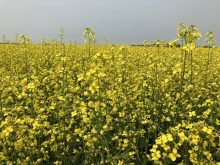Canada is gaining ground in the world’s second largest feed barley market at the expense of the United States.
The U.S. was shut out of Japan’s fifth and final Simultaneous Buy and Sell or SBS barley tender of the year on Nov. 30, leaving the spoils to be split between Canada and Australia.
Japanese importers purchase the bulk of their feed barley through the SBS tenders and this was the second one in a row where American exporters came up empty-handed after accounting for 32 percent of the trade stemming from the first three tenders of 2005.
Read Also

Bond market seen as crop price threat
A grain market analyst believes the bond market is about to collapse and that could drive down commodity values.
“This is obviously not good news for U.S. barley,” said Ryan LeGrand, manager of international operations for the U.S. Grains Council.
During a recent trade mission to Japan, the council discovered how miffed Japanese buyers were at the high level of green peas found in U.S. barley shipments.
The largest importer in the country told a council representative it would not purchase any more U.S. barley until the issue was resolved.
Canadian Wheat Board spokesperson Maureen Fitzhenry said Canada has benefited from the absence of U.S. competition in Japan but attributed the disappearance to a different reason.
“The fact that the U.S. was out on the last few (tenders) was probably because of price,” she said.
American barley supplies are tighter than they have been in 40 years, which has driven domestic prices above what the crop is trading for on international markets.
U.S. barley is also suffering from record levels of fusarium contamination.
Fitzhenry said those two factors prompted Japanese importers to buy 5.5 million bushels from Australia, 4.59 million bu. from Canada and nothing from the U.S. during the latest round of tenders.
Japan is Canada’s largest feed barley market, with average purchases of about 300,000 tonnes per annum over the past 10 years.
Anything that builds on that success is a plus, so Fitzhenry said the fact that Canada has the ability to segregate crops like peas and barley means it is poised to take advantage of the U.S. problem should it become a bigger trade factor.
It already is a huge factor, said Steve Johnson, executive director of the Idaho Grain Producers Association.
“We worked very hard to open that market up, so this is a significant setback for us,” he said.
Japan is also America’s largest export market for feed barley so the industry is taking the Japanese objections to heart.
“It’s a very concerning issue to the barley industry, particularly in the Pacific Northwest,” said Johnson.
Industry groups are working with exporters, elevators and producers in Washington, Oregon, Idaho, Montana and North Dakota to find a solution to the commingling problem.
Johnson said one explanation for the rise in pea contamination could involve the surge in American pea acreage, which grew by 52 percent last year alone.
He expects more acres of barley are being produced on green pea land, so there may be some volunteer issues for farmers to deal with.
There could also be some blending problems at country and export elevators. Instead of cleaning its grain like Canada does, the U.S. blends the crop to meet certain quality specifications.
The Japanese buy a No. 2 quality blend from the U.S., but lately that is not meeting their needs. If they switched to buying a No. 1 blend it would come within their foreign material tolerance levels, said Johnson.
The next SBS tender will not take place until mid-March 2006.
















